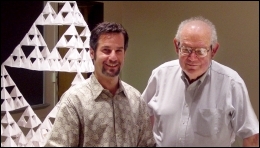Fractal Music
A quick Web search will reveal many misconceptions regarding what constitutes fractal music.
| |

|
| |
Harlan Brothers with Benoit Mandelbrot at Yale
[Click image to enlarge] |
During an informal discussion in 2003 regarding the apparent lack of clarity associated with the subject, the late Benoit Mandelbrot suggested to Harlan Brothers that he undertake a mathematically rigorous treat- ment of fractal music. The first result was a lecture and lab Brothers presented at the 2004 Fractal Geometry Summer Workshop at Yale. He subsequently published a paper entitled "Structural Scaling in Bach’s Cello Suite No. 3," which appeared in the journal Fractals (Vol. 15, No. 1, 2007; pages 89-95). The article reveals musical structure related to the Cantor set and helps to establish a mathematical foundation for the classification of fractal music. A more recent article, entitled "Intervallic Scaling in the Bach Cello Suites," also appears in Fractals (Vol. 17, No. 4, 2009; pages 537-545). The paper describes a novel and robust approach to establishing the existence of power-laws in music.
Brothers is currently appearing in Michael Lawrence's new documentary, Bach & Friends where he discusses Bach, mathematics, and fractal geometry. The film includes his zoom animation into the Mandelbrot set. Here is information regarding the fractal zoom.
He recently produced a compilation of fractal music in honor of Benoit Mandelbrot hosted at the Yale Peabody Museum for Science Writers 2010. The program and dedication can be found here.
One of Brothers' early realizations was that musicians have been composing a form of fractal music for at least six centuries. Motivic scaling was familiar to many of the great Flemish composers such a Johannes Ockeghem and Josquin des Prez who developed the art of the mensuration or prolation canon. This type of canon is characterized by a melody or rhythmic motif that is repeated in different voices simultaneously at different tempos (here is an example). To be clear, not all mensuration canons are fractal; there are fundamental requirements that must be met in order to classify an object as such.
Modern composers, including Martin Bresnick, Conlon Nancarrow, and Arvo Pärt, have developed sophisticated compositional styles that often incorporate forms of motivic scaling. Many algorithmic artists also utilize this concept in their compositions. The Fractal Music Composer software, written for the Fractal Geometry Workshop, offers one the opportunity to experiment with composing fractal music in this time-honored style.
As with graphics, music can exhibit a wide variety of scaling behavior. In the course of exploring the role of power laws in music, Brothers has identified many types of scaling including, among others, self-similarity with respect to duration, pitch, interval, motif, and structure.
He has also written compositions to illustrate some of these scaling char-acteristics. The links below provide audio examples along with their descriptions (background information can be found here). While some of the compositions are too short to properly be considered fractal, they offer a hint of what one might listen for when searching for similar structure in the vast body of musical expression.
(Please note: Javascript must be enabled to listen to these compositions and read their descriptions.)
| Combined Duration & Pitch Scaling: |
Here are some links to other work on the subject:

